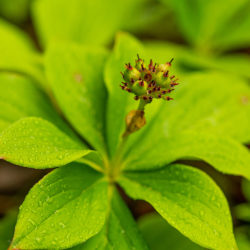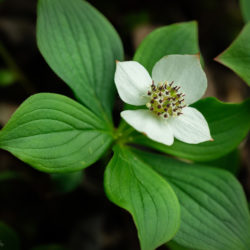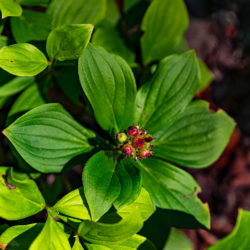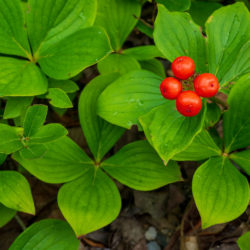Etymology
Chamaepericlymenum comes from the Greek: chamae for low-growing or humble, and periclymenum for climbing plant. The species name canadense is derived from Latin for northern, or from Canada. The family name comes from the Latin cornus/cornella for horn/small horn.
Formerly classified as Cornus canadensis or Cornella canadensis.
Native Habitat
Grows in extensive patches in cool, moist, acidic, partly-shaded woodlands, swamps, wetland margins, and mountain slopes. Plant communities include peat moss and pine trees. At the base of pine trees, you will find bunchberry covered in pine needles. This is a natural beneficial mulch for this acidic-loving groundcover. Its natural range extends from Greenland across northern North America. It is present in all of the New England States. Hardiness Zones 2-6.
Garden Uses
Considered one of the smallest of the dogwood family, bunchberry makes an excellent groundcover in the moist woodland garden and is attractive over 3 seasons with lovely white blooms, brightly colored fruit, and autumn color change. Mulching with pine needles and peat moss may be beneficial.
Overview
One of two herbal dogwoods, plant height is typically 3-8 inches. Tolerates sun to shade with sufficient moisture and acidity.
Leaves and Stems
Bunchberry will maintain the green of its leaves well into the fall. Leaves may be tinged or change completely to wine-red in late fall. The slender 3-6" stalks of this perennial, woodland groundcover are topped by a whorl of oval, pointed leaves above which rises a white to greenish, dogwood blossom. Leaves are entire (not lobed), simple, oval, pointed at the tip, smooth-edged, and whorled (4 doubly opposite leaves grow from each single node). Erect stems grow in extensive low patches.
Flowers
Generally flowers April–June in Maine. Here, petals (bracts) are usually white; however, colors may vary from blue, purple, green, brown, white and yellow. Flowers are in a cluster in the center and surrounded by a whorl of 4 showy white or pinkish bracts, giving the appearance of a single flower on a short stem. Bunchberries have four petals, sepals and tepals. Total flower-head is 1-1/2 inches across.
Fruit/Seed
Bunchberry fruit appears as a cluster of bright red berries. Each berry is a drupe in that it is fleshy and encloses a single seed. When ripened, the fruit is bright red in color. Seeds within each fruit are tiny. The seed is smooth and is longer than it is wide. It fruits in mid-July in Maine.
Wildlife Associates
Flowers attract insect pollinators, and berries are favored by birds.
Bunchberry provides a food source for some species of wildlife. In some parts of its range, white-tailed deer consume bunchberry foliage as do moose, although this plant does not appear to be a preferred food source for them. Bunchberry fruits are eaten by American black bears and small mammals. Eastern chipmunks, American martens, Eastern cottontails, and snowshoe hares feed on bunchberry stems and fruits. Bunchberry is also used by some song and game birds.
Propagation
Requires pollination from another, unrelated plant of its species (obligate out-crossing). To accomplish this, pollen is explosively released by stored elastic energy in flower anthers, and accelerates post release at a rate of 24,000 meters per second, to remain suspended at altitudes of up to 2 inches, before settling on receptive stigma of unrelated plants. Bunchberry is rhizomous, spreading by underground stems; cuttings taken in July/August can be rooted in 1:1 sand/peat mixture, taken below ground level in July or August. Alternatively, whole dried fruit can be planted, with new plants blooming year 3. Benefits from 3-month cold stratification.
Ethnobotanical Uses
Native American tribes used the plant medicinally for a variety of ailments. Additionally, the berries were used in ceremonies and as a food source either eaten as a snack or mixed with other berries in woodland settings. Red berries are an edible trail food, though some people describe them as tasteless and mealy.
Garden Location
Performance Hall Garden (see garden map)
Sources
Eyed, Richard H. 1988. Comprehending Cornus: puzzles and progress in the systematics of the dogwoods. Botanical Review. 54(3): 233-351.
Illustrated Guide to Flower Families of Crete
Lady Bird Johnson Wildflower Center
University of Maine Cooperative Extension
Plant Profile by Kate O’Dell & Ivonne Vazquez




